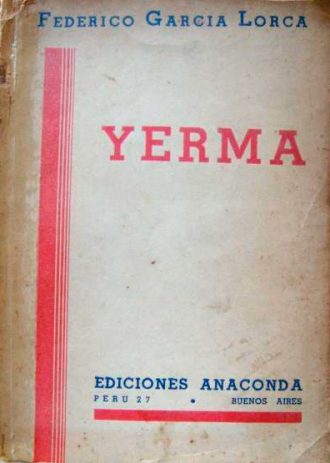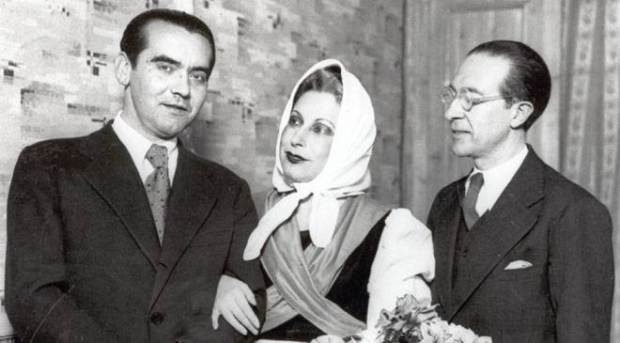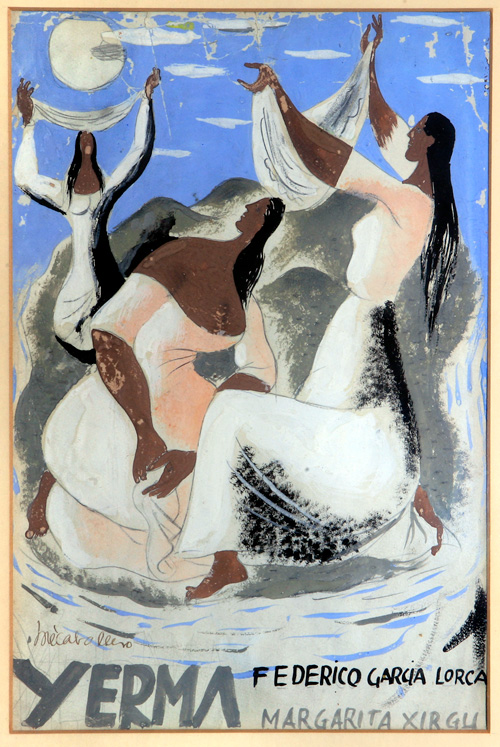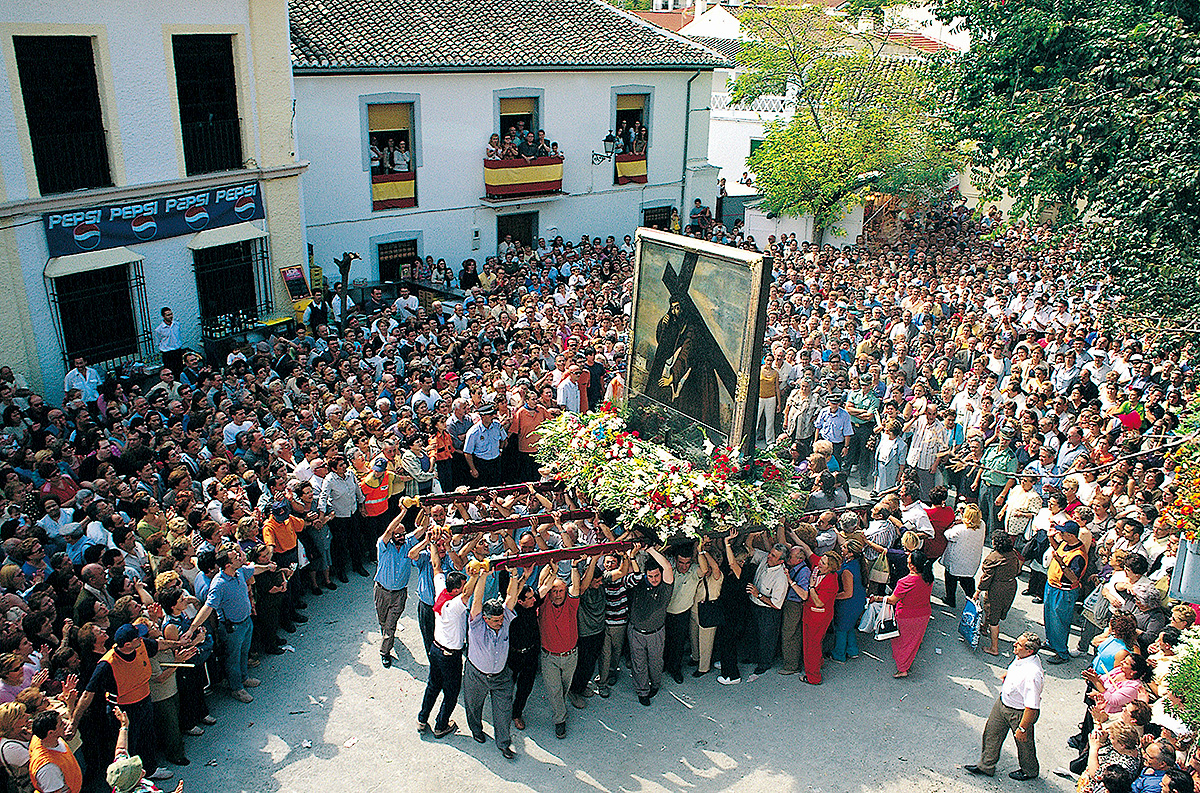
The central issue is about infertility or, in other words, about the reproductive instinct to reproduce in the face of the repression of the senses in a rural environment in which the lack of fertility has the overtones of a curse.
Yerma, at the beginning, still has some hope of conceiving a child of her own, like her friends. Marriage to Juan, a peasant, was imposed on her by her father. The liaison, she says, she accepted less for “fun” than for the child she longs for and who does not come. Despite her willingness, she does not succeed and her house is transformed into a hell. “When he covers me he does his duty, but I notice his waist is cold as if his body were dead and I, who have always been disgusted by hot women, wanted to be at that moment like a mountain of fire” (Act III, Part I).
Yerma calls on Dolores, a kind of sorceress who has helped other women to conceive. While she is still at home, Juan and his sisters-in-law appear. They have a heated argument, Juan asks her what she is looking for there, a married woman, and Yerma replies: “I am looking for you. I am looking for you. It is you that I look for day and night without finding shade to breathe. It is your blood and your protection that I want” (Act III, Part I).

The tragedy culminates in the last act, a pilgrimage where infertile women come to ask Christ for children. The Old Woman, who had already appeared in the first act, offers her son to make her pregnant: “My house needs a woman. Go with him and the three of us will live together. My son is of blood. Like me. If you come into my house there is still the smell of cradles”. Yerma rejects the offer, but suddenly runs into her husband who has overheard the conversation and confesses: “Without children life is sweeter. I am happy not having them”.
Juan tries to kiss Yerma, but she reacts violently and strangles him in the middle of the field. The play ends with a heartbreaking scream. Yerma in her eagerness to have a child ends up killing the only man who, according to convention, can make her a mother: “Do not come near me because I have killed my son, my son, I myself have killed my son. I myself have killed my son! (Act III, Part II).
Teatro Español, Madrid, on December 29, 1934. Actors: Margarita Xirgu, Enrique Diosdado, Ricardo Merino, Pilar Muñoz. Carlos Collado, Pedro López Lagar and Eloísa Vigo.
Its premiere was already involved in the hostile atmosphere that preluded the Civil War. Margarita Xirgu’s friendship with Manuel Azaña, whose drama The crown, had starred, and her commitment to the cause of the Republic provoked a hint of rebellion among the conservative public.
The first edition appeared in 1937 in Buenos Aires at the Anaconda Publishing House.

The pilgrimage with which Yerma ends is inspired by that of the Cristo del Paño de Moclín (Christ of the Cloth of Moclín) (a village located at the eastern end of the Granada region of Loja province). The pilgrimage dates back to the 17th century and is still celebrated every October 5. A human stream climbs the hill where the hermitage stands venerating the rather rough canvas of the Cristo del Paño to ask for favors of all kinds.
The legend about the bacchanals, orgies and pagan rites in which the pilgrimage ended at night, caused a bad reputation that even led to its prohibition by the Franco regime. In the family house in Valderrubio, the García Lorca family kept a lithograph of the Cristo del Paño, very popular in the Vega despite its heretical dissonances, which must have inspired Federico. For Francisco, it was an expression of popular inventiveness, but for Isabel, it was a pilgrimage “full of scandal, of violence”. Both confess, however, that they were never there.

Before writing Yerma, García Lorca, together with his friend Cipriano Rivas Cherif, devised a ballet with music by Gustavo Pittaluga in 1930 with a humorous tone entitled La romería de los cornudos (The Pilgrimage of Cuckolds) which was premiered in 1933 by the company of Margarita Xirgu and which alludes to the pilgrimage of Moclín. It could be the predecessor of Yerma.
The scene of the washerwomen (Act II, Part I) is inspired by the women Lorca used to meet on his youthful walks at the La Carrura fountain, now disappeared, on the banks of the river Cubillas, between Pinos Puente and Valderrubio.
In the play, the washerwomen sing songs in a carefree tone alluding to infecundity: “Yo planté un tomillo [I planted thyme], yo lo vi crecer./ [I saw it grow], / El que quiera honra [He who wants honor] / que se porte bien (Ríen) [let him behave well (they laugh)]”. Or they make cruel allusions: “Those macho women are like that: when they could be making lace or apple jams they like to climb on the roof and walk barefoot along those rivers”.
Yerma was largely worked on and written during the summers of 1933 and 1934 in the Huerta de San Vicente (San Vicente Farmhouse). In 1933, Federico lived in the Farmhouse from mid-July to August 8, when he enrolled in the second outing of La Barraca. During those days he wrote the first two acts. In the summer of 1934, he stayed twice in the Farmhouse. During the first stay, from July 16 to August 1 (a few days before the fatal bullfight of the bullfighter Ignacio Sánchez Mejías to whom he dedicated his harrowing Lament for a Bullfighter, he managed to finish the first complete version, although he retouched the third act. He finished it on July 24, 1934 and read it in the Farmhouse itself and later at the Casa de los Tiros before a group including Antonio Gallego Burín, Emilio García Gómez and Francisco Prieto-Moreno, among others.
In an interview signed by Nicolás González-Deleito published in the Madrid magazine Escena, in May 1935, he evokes his leisurely way of writing: “It took me five years to write Blood wedding; three I invested in Yerma… Both works are the fruit of reality. Their figures are real; as is the theme of each of them… First note, observations taken from life itself, from the newspaper at times… Then, thinking about the subject. A long, constant, detailed thought. And finally, the final transfer: from the mind to the stage…”.
Lorca defined his rural tragedy in this way: “Yerma is a body of typical tragedy that I have dressed in modern clothes; it is, above everything else, the image of fertility punished by sterility. A soul which destiny has targeted as a victim of the infertile. In fact, I wanted to make the living poem of infertility, using the dead line of the infertile. And it is from there, from the opposite of the sterile and the life-giving, that I draw the tragic profile of the play (…). Yerma is my fourth play. And I couldn’t feel more disappointed than if people thought that my theatrical work culminated in any of the titles already known”. (Interview by Alfredo Muñiz in El Heraldo de Madrid on December 26, 1934).
Life of García Lorca, Poet
José R. Luna
(Interview published in Crítica of Buenos Aires on May 10,1934)
“My first emotions are linked to the land and to the work in the fields. That is why there is what psychoanalysts would call an agricultural complex in my life. Without this love for the land I would not have been able to write Blood Wedding. And I would not have started my next work Yerma. I find strong evidence of poverty in the land, and I love poverty above everything else, not the sordid and hungry poverty but the blessed poverty, simple and humble, like brown bread”.
Yerma, produced by the National Drama Center.